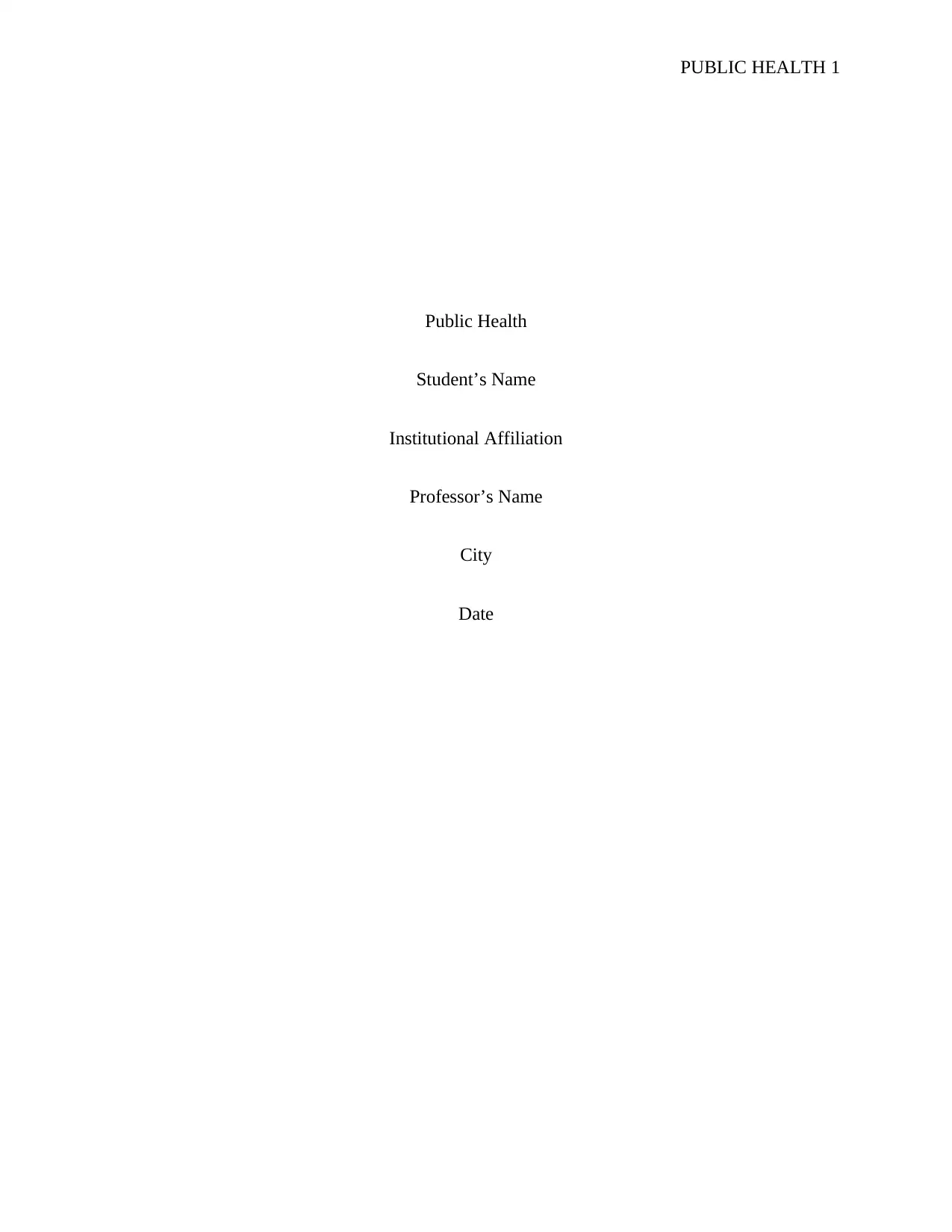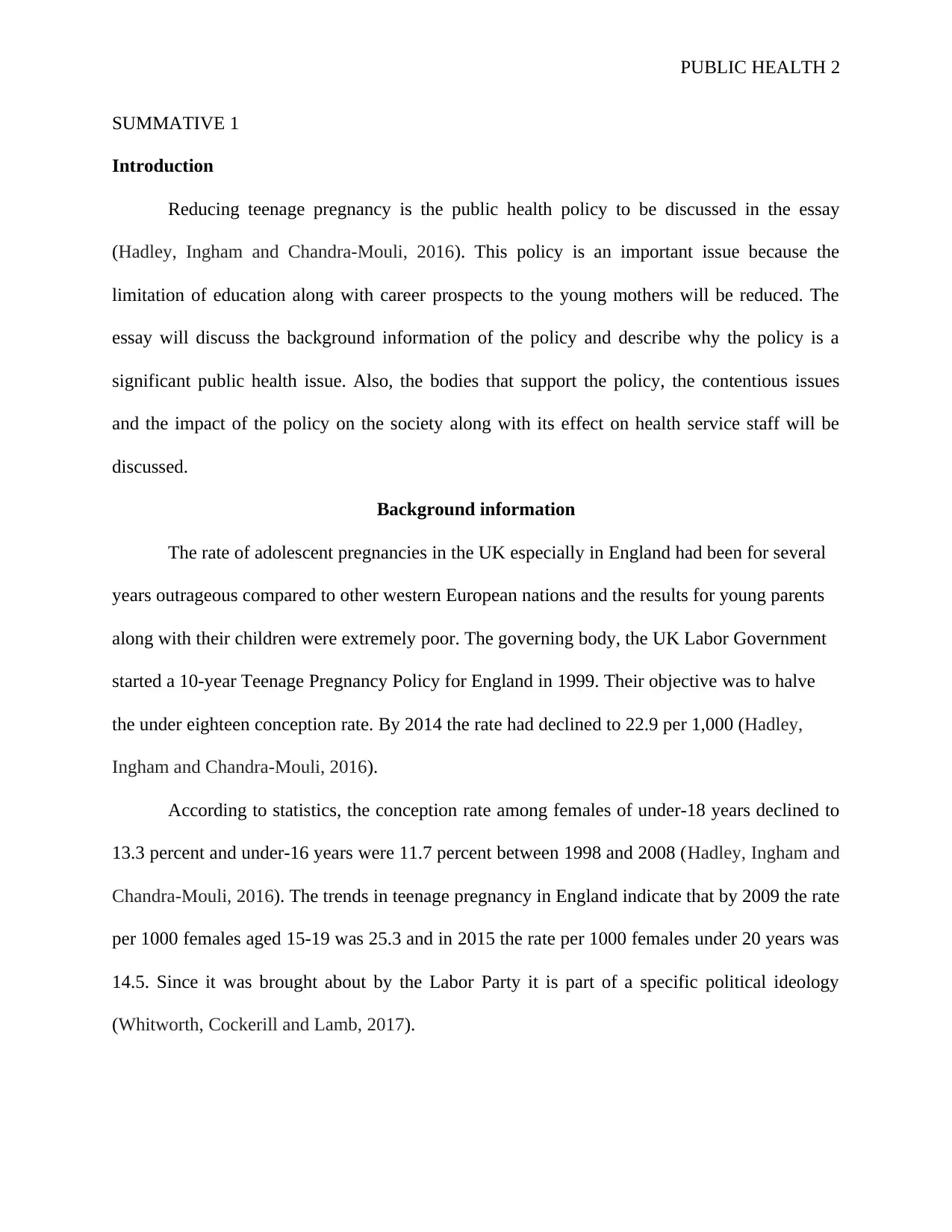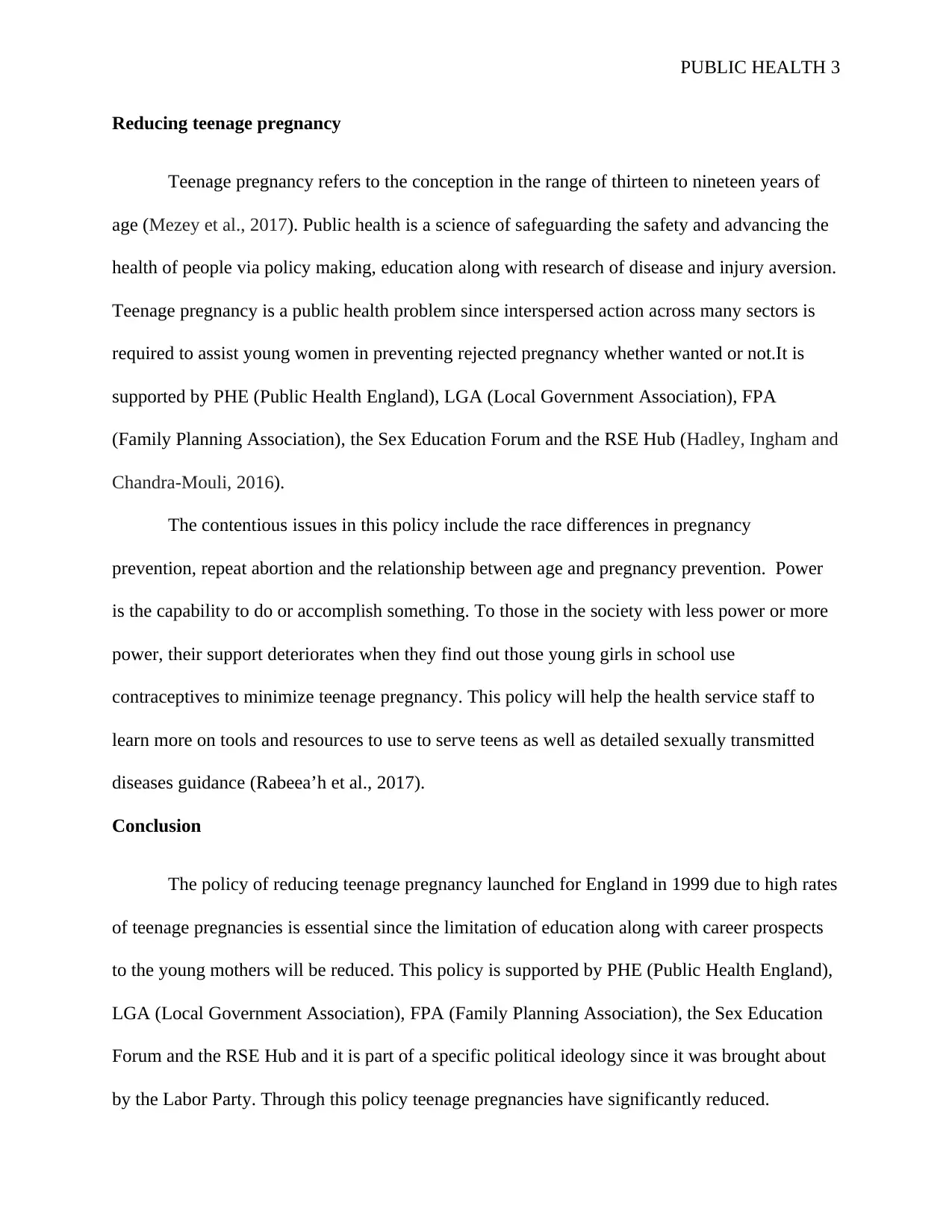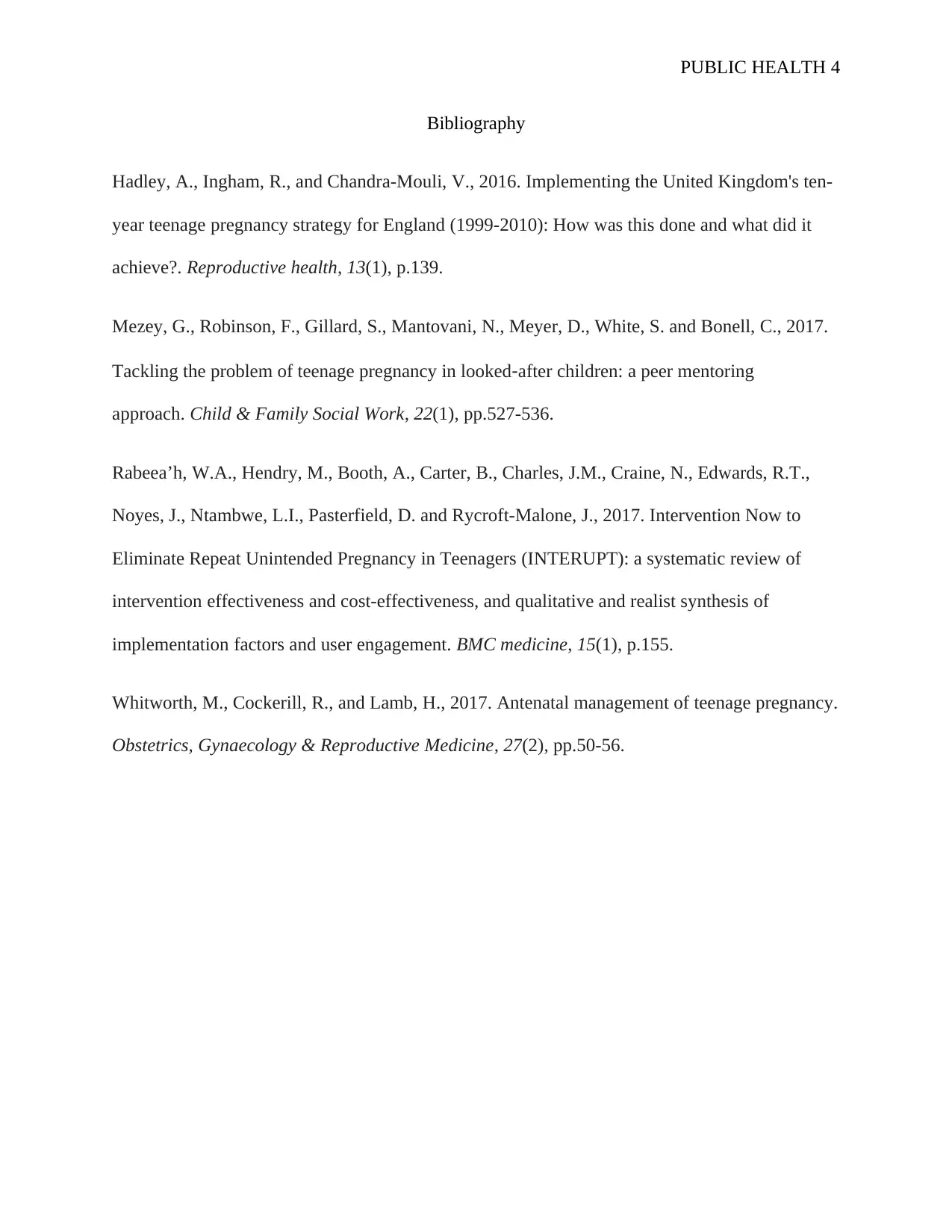Essay on Public Health Policy: Teenage Pregnancy Reduction
VerifiedAdded on 2023/04/23
|4
|883
|93
Essay
AI Summary
This essay examines the UK's public health policy aimed at reducing teenage pregnancy, initiated in 1999 by the Labor Government. The essay provides background information on the policy, highlighting the high rates of teenage pregnancies in the UK compared to other Western European nations. It discusses the policy's significance as a public health issue, emphasizing the limitations it places on young mothers' education and career prospects. The essay explores the supporting bodies, contentious issues such as race differences in pregnancy prevention, and the policy's impact on society and health service staff. The essay also references statistics showing a decline in teenage pregnancy rates. It concludes by reiterating the policy's importance in reducing teenage pregnancies and acknowledging its political origins and impact.

PUBLIC HEALTH 1
Public Health
Student’s Name
Institutional Affiliation
Professor’s Name
City
Date
Public Health
Student’s Name
Institutional Affiliation
Professor’s Name
City
Date
Paraphrase This Document
Need a fresh take? Get an instant paraphrase of this document with our AI Paraphraser

PUBLIC HEALTH 2
SUMMATIVE 1
Introduction
Reducing teenage pregnancy is the public health policy to be discussed in the essay
(Hadley, Ingham and Chandra-Mouli, 2016). This policy is an important issue because the
limitation of education along with career prospects to the young mothers will be reduced. The
essay will discuss the background information of the policy and describe why the policy is a
significant public health issue. Also, the bodies that support the policy, the contentious issues
and the impact of the policy on the society along with its effect on health service staff will be
discussed.
Background information
The rate of adolescent pregnancies in the UK especially in England had been for several
years outrageous compared to other western European nations and the results for young parents
along with their children were extremely poor. The governing body, the UK Labor Government
started a 10-year Teenage Pregnancy Policy for England in 1999. Their objective was to halve
the under eighteen conception rate. By 2014 the rate had declined to 22.9 per 1,000 (Hadley,
Ingham and Chandra-Mouli, 2016).
According to statistics, the conception rate among females of under-18 years declined to
13.3 percent and under-16 years were 11.7 percent between 1998 and 2008 (Hadley, Ingham and
Chandra-Mouli, 2016). The trends in teenage pregnancy in England indicate that by 2009 the rate
per 1000 females aged 15-19 was 25.3 and in 2015 the rate per 1000 females under 20 years was
14.5. Since it was brought about by the Labor Party it is part of a specific political ideology
(Whitworth, Cockerill and Lamb, 2017).
SUMMATIVE 1
Introduction
Reducing teenage pregnancy is the public health policy to be discussed in the essay
(Hadley, Ingham and Chandra-Mouli, 2016). This policy is an important issue because the
limitation of education along with career prospects to the young mothers will be reduced. The
essay will discuss the background information of the policy and describe why the policy is a
significant public health issue. Also, the bodies that support the policy, the contentious issues
and the impact of the policy on the society along with its effect on health service staff will be
discussed.
Background information
The rate of adolescent pregnancies in the UK especially in England had been for several
years outrageous compared to other western European nations and the results for young parents
along with their children were extremely poor. The governing body, the UK Labor Government
started a 10-year Teenage Pregnancy Policy for England in 1999. Their objective was to halve
the under eighteen conception rate. By 2014 the rate had declined to 22.9 per 1,000 (Hadley,
Ingham and Chandra-Mouli, 2016).
According to statistics, the conception rate among females of under-18 years declined to
13.3 percent and under-16 years were 11.7 percent between 1998 and 2008 (Hadley, Ingham and
Chandra-Mouli, 2016). The trends in teenage pregnancy in England indicate that by 2009 the rate
per 1000 females aged 15-19 was 25.3 and in 2015 the rate per 1000 females under 20 years was
14.5. Since it was brought about by the Labor Party it is part of a specific political ideology
(Whitworth, Cockerill and Lamb, 2017).

PUBLIC HEALTH 3
Reducing teenage pregnancy
Teenage pregnancy refers to the conception in the range of thirteen to nineteen years of
age (Mezey et al., 2017). Public health is a science of safeguarding the safety and advancing the
health of people via policy making, education along with research of disease and injury aversion.
Teenage pregnancy is a public health problem since interspersed action across many sectors is
required to assist young women in preventing rejected pregnancy whether wanted or not.It is
supported by PHE (Public Health England), LGA (Local Government Association), FPA
(Family Planning Association), the Sex Education Forum and the RSE Hub (Hadley, Ingham and
Chandra-Mouli, 2016).
The contentious issues in this policy include the race differences in pregnancy
prevention, repeat abortion and the relationship between age and pregnancy prevention. Power
is the capability to do or accomplish something. To those in the society with less power or more
power, their support deteriorates when they find out those young girls in school use
contraceptives to minimize teenage pregnancy. This policy will help the health service staff to
learn more on tools and resources to use to serve teens as well as detailed sexually transmitted
diseases guidance (Rabeea’h et al., 2017).
Conclusion
The policy of reducing teenage pregnancy launched for England in 1999 due to high rates
of teenage pregnancies is essential since the limitation of education along with career prospects
to the young mothers will be reduced. This policy is supported by PHE (Public Health England),
LGA (Local Government Association), FPA (Family Planning Association), the Sex Education
Forum and the RSE Hub and it is part of a specific political ideology since it was brought about
by the Labor Party. Through this policy teenage pregnancies have significantly reduced.
Reducing teenage pregnancy
Teenage pregnancy refers to the conception in the range of thirteen to nineteen years of
age (Mezey et al., 2017). Public health is a science of safeguarding the safety and advancing the
health of people via policy making, education along with research of disease and injury aversion.
Teenage pregnancy is a public health problem since interspersed action across many sectors is
required to assist young women in preventing rejected pregnancy whether wanted or not.It is
supported by PHE (Public Health England), LGA (Local Government Association), FPA
(Family Planning Association), the Sex Education Forum and the RSE Hub (Hadley, Ingham and
Chandra-Mouli, 2016).
The contentious issues in this policy include the race differences in pregnancy
prevention, repeat abortion and the relationship between age and pregnancy prevention. Power
is the capability to do or accomplish something. To those in the society with less power or more
power, their support deteriorates when they find out those young girls in school use
contraceptives to minimize teenage pregnancy. This policy will help the health service staff to
learn more on tools and resources to use to serve teens as well as detailed sexually transmitted
diseases guidance (Rabeea’h et al., 2017).
Conclusion
The policy of reducing teenage pregnancy launched for England in 1999 due to high rates
of teenage pregnancies is essential since the limitation of education along with career prospects
to the young mothers will be reduced. This policy is supported by PHE (Public Health England),
LGA (Local Government Association), FPA (Family Planning Association), the Sex Education
Forum and the RSE Hub and it is part of a specific political ideology since it was brought about
by the Labor Party. Through this policy teenage pregnancies have significantly reduced.
⊘ This is a preview!⊘
Do you want full access?
Subscribe today to unlock all pages.

Trusted by 1+ million students worldwide

PUBLIC HEALTH 4
Bibliography
Hadley, A., Ingham, R., and Chandra-Mouli, V., 2016. Implementing the United Kingdom's ten-
year teenage pregnancy strategy for England (1999-2010): How was this done and what did it
achieve?. Reproductive health, 13(1), p.139.
Mezey, G., Robinson, F., Gillard, S., Mantovani, N., Meyer, D., White, S. and Bonell, C., 2017.
Tackling the problem of teenage pregnancy in looked‐after children: a peer mentoring
approach. Child & Family Social Work, 22(1), pp.527-536.
Rabeea’h, W.A., Hendry, M., Booth, A., Carter, B., Charles, J.M., Craine, N., Edwards, R.T.,
Noyes, J., Ntambwe, L.I., Pasterfield, D. and Rycroft-Malone, J., 2017. Intervention Now to
Eliminate Repeat Unintended Pregnancy in Teenagers (INTERUPT): a systematic review of
intervention effectiveness and cost-effectiveness, and qualitative and realist synthesis of
implementation factors and user engagement. BMC medicine, 15(1), p.155.
Whitworth, M., Cockerill, R., and Lamb, H., 2017. Antenatal management of teenage pregnancy.
Obstetrics, Gynaecology & Reproductive Medicine, 27(2), pp.50-56.
Bibliography
Hadley, A., Ingham, R., and Chandra-Mouli, V., 2016. Implementing the United Kingdom's ten-
year teenage pregnancy strategy for England (1999-2010): How was this done and what did it
achieve?. Reproductive health, 13(1), p.139.
Mezey, G., Robinson, F., Gillard, S., Mantovani, N., Meyer, D., White, S. and Bonell, C., 2017.
Tackling the problem of teenage pregnancy in looked‐after children: a peer mentoring
approach. Child & Family Social Work, 22(1), pp.527-536.
Rabeea’h, W.A., Hendry, M., Booth, A., Carter, B., Charles, J.M., Craine, N., Edwards, R.T.,
Noyes, J., Ntambwe, L.I., Pasterfield, D. and Rycroft-Malone, J., 2017. Intervention Now to
Eliminate Repeat Unintended Pregnancy in Teenagers (INTERUPT): a systematic review of
intervention effectiveness and cost-effectiveness, and qualitative and realist synthesis of
implementation factors and user engagement. BMC medicine, 15(1), p.155.
Whitworth, M., Cockerill, R., and Lamb, H., 2017. Antenatal management of teenage pregnancy.
Obstetrics, Gynaecology & Reproductive Medicine, 27(2), pp.50-56.
1 out of 4
Related Documents
Your All-in-One AI-Powered Toolkit for Academic Success.
+13062052269
info@desklib.com
Available 24*7 on WhatsApp / Email
![[object Object]](/_next/static/media/star-bottom.7253800d.svg)
Unlock your academic potential
Copyright © 2020–2025 A2Z Services. All Rights Reserved. Developed and managed by ZUCOL.





